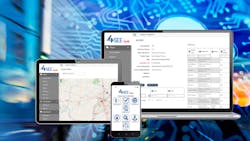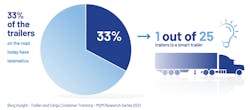What is a smart trailer?
Historically, trailers are “unintelligent” devices, meaning that they respond only to external inputs. This one-way dialog leaves untapped potential in the form of information embedded within the trailer that’s valuable when extracted and understood. This includes data about the status of each subsystem of the trailer and can include temperature and humidity of zones within the trailer, wheel-end temperature, tire pressure, cargo presence, trailer weight, lamp health, door openings, and more.
The more data that can be derived from, and provided to, a trailer, the more value that can be tapped.
Today, trailer components are often designed to produce these data streams. Tires now have embedded sensors. ABS units now output data separately from the power-line-carrier (PLC). Each component has its own method of measuring and disseminating this information. For this reason, 33% of the trailers on the road today could be considered to have telematics. However, it’s when these data outputs are aggregated and contextualized that it becomes a valuable asset, and a true smart trailer.
How can carriers benefit from smart trailers?
While there’s a long and growing list of benefits, Grote views the benefits as all falling into 4 distinct categories:
- Safety (ie: smart lamps and proximity sensors)
- Security (ie: trailer tracking and cargo door monitoring)
- Efficiency (ie: cargo sensing and tire pressure monitoring)
- Cost savings (ie: reduction of CSA violations and insights that lead to operational improvements,
This is just a portion of the numerous benefits that can be gained from smart trailers. These can not only help fleets be more profitable – but can also make the roads a safer place for everyone.
What criteria should you consider before choosing a solution?
- Integration. How are the various components connected? Is the connection reliant on Bluetooth or WiFi, or is there a hardwired connection that ensures reliability? If it’s wired, how easy is it to retrofit and does the wiring harness allow for customization based on your operation’s needs? Grote’s unique wiring harness allows for easy customization and retrofitting while delivering a safe, secure connection to all components. Grote’s proprietary connectors are designed for an open architecture, allowing compatibility with other systems.
- How scalable is the solution? Is the solution backward compatible with legacy trailer devices? Does the solution offer a modular ecosystem that’s future ready for upcoming advancements in trailer hardware? How does the smart trailer system integrate with cab data outputs your organization is currently leveraging? The fact is that you need a system that just works, whether it’s with new sensors and smart lamps, or legacy lamps and other devices. Grote’s 4SEE Secure converter modules will convert all other communication protocols to J1939 standard communications. It will also ensure that all items have an independent communication stream that does not interfere with other hardware in the system.
- Durability. Commercial vehicles and the trailers they pull are subjected to harsh conditions. The technology that you add to your trailers is only as effective as it is durable. If the smart trailer solution is reliant on a nose box, it’s imperative that the nose box is tightly sealed off from water damage. All wiring that’s used for the system also needs to be sealed and all connection points should be corrosion resistant. If a system requires you to use dielectric grease in order to prevent water ingress, then this is an additional maintenance operation for you to undertake and is messy to deal with. 4SEE’s smart nose box is sealed to IP69K standards for water ingress protection while the wiring harness is sealed without the use of grease and is designed to last for 20 years in the harshest of conditions. The terminals are gold-plated for resistance to corrosion which helps ensure the secure and accurate transfer of data.
- Camera coverage. One of the best ways for a carrier to mitigate their risk is by leveraging cameras. Smart trailers can employ cameras in multiple locations, so it’s important to consider what visibility you require for your operation. The 4SEE smart trailer system offers visibility to the sides, rear, and interior of the trailer. This helps to provide you with coverage against damage and theft to both the trailer itself as well as any cargo that you’re transporting. The video feed is logged to a DVR which can be retrieved using the SD card. This means that you won’t lose the feed due to spotty WiFi or a lost Bluetooth connection.
- Load and location. The geo-location of your trailer is basic table stakes for a connected trailer. However, having more information about the cargo offers tremendous cost-savings potential. Cargo sensors can be leveraged to alert you to a shift in cargo and can help inform you as to what percentage of your cargo capacity is being utilized. The 4SEE system allows a fleet manager to know exactly where each of their trailers are at all times. Just as importantly, 4SEE’s network of cargo sensors can help prevent against cargo damage while also allowing fleets to optimize their operations to ensure that they’re using their cargo capacity to its fullest potential.
- Actionable insights. Data needs to be organized and contextualized in order to be of maximum value. Providing access and notifications to your drivers can help improve safety by notifying them to a component malfunction. An interface for your fleet managers can provide them with insights that allow them to do their job more effectively and optimize operations across the fleet. It’s also important to understand how a solution can integrate with partners for data sharing so that you can have all the information in one place. The 4SEE system by Grote offers a mobile app for drivers to keep them aware of equipment and cargo conditions while on the road. Meanwhile, the 4SEE web interface provides fleet managers with powerful insights right at their fingertips. To better understand the value that 4SEE by Grote offers for carriers, visit Grote.com/4SEE to access an interactive tool that explains how you can benefit from this powerful solution.
To learn more, visit Grote.com/4SEE.

